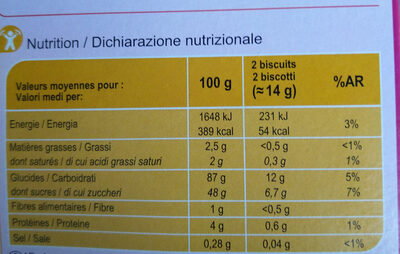Piccolos à la framboise - Carrefour - 100 g (2 x 50 g)
This product page is not complete. You can help to complete it by editing it and adding more data from the photos we have, or by taking more photos using the app for Android or iPhone/iPad. Thank you!
×
Some of the data for this product has been provided directly by the manufacturer Carrefour.
Barra-kodea: 3560070252053 (EAN / EAN-13)
Izen arrunta: Biscuits nappage (35%) à la framboise, aromatisés.
Kopurua: 100 g (2 x 50 g)
Markak: Carrefour
Etiketak, ziurtagiriak, sariak:
en:Green Dot
Dendak: Carrefour, carrefour.fr
Matching with your preferences
Ingurumena
Ontziratzea
Transportation
Other information
Conservation conditions: Conservation : À conserver à l'abri de la chaleur et de l'humidité. Pour une dégustation optimale, à consommer de préférence avant le / N° de lot : voir sur le dessus du pack.
Customer service: Interdis - TSA 91431 - 91343 MASSY Cedex - France
Report a problem
Datuen iturria
Product added on by kiliweb
Last edit of product page on by spotter.
Produktuaren orria -gatik editatua autorotate-bot, bougnat4812, driveoff, henri400, openfoodfacts-contributors, org-carrefour, teolemon, yuka.RjRBakFaVThoc2NWeGZFOC96bU1vOTF4NDg2cEJUbTlGOVk0SUE9PQ.








